Korfball drills for technique condition / strength
- Players run/dribble around a set square. (poles/pawns, sufficient distance from each other).
- Players are given a list of commands in advance, with a corresponding number.
- The trainer calls out a number randomly, players carry out the assignment.
- You can adjust the number of missions and the missions themselves.
- Example of assignments.
- Tapping the ground.
- Jump in the air.
- Sprint to the next pole.
- 1 burpee.
- Backwards as if you are defending until the next pole/pawn.
- Ladder exercise with run through ball
- 1 foot in the ladder, 1 foot next to it, as fast as possible through the ladder and score 15 times
- Sideways through the ladder with two feet in each compartment, 15 x scoring, easy pace
- Start left of the ladder on left leg. Hop on right leg into the ladder and then next to it. Then with left leg into the ladder and next to it, then with right leg again and finish with a through ball. Do this quietly (strengthen ankle joint)
- Ladder exercise without ball
- With two feet in each rung, so small steps as fast as possible(5x per person)
- Skating over the ladder from the left side outside the ladder to the right side outside the ladder.
- 10 short sprints along the ladder with the ball. (as fast as possible)
Doubles:
- Number 1 in front of the basket (6 meters),
- Number 2 with ball under the basket. 1 pawn left or right of the basket at about 4 to 6 metres.
- Number 2 throws the ball to number 1.
- Number 1 puts the ball on the ground and runs to the pawn and around it towards the basket.
- In the meantime, number 1 runs to the ball on the ground and passes it to number 2 for a deep pass.
- This is repeated until 8 balls have been made.
- The pace is important:
- The runners may not stand still, but you may not run too slowly.
- The timing of the passing must be correct.
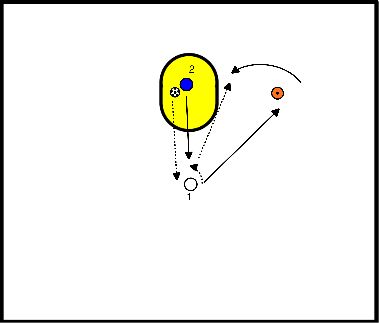
Pairs:
- Number 1 with the ball starts in front of the basket.
- Number 2 stands left or right in front of the basket.
- Number 1 throws to number 2 and then pulls away to the side where number 2 is not standing.
- So number 2 is on the left side of the basket, number 1 walks to the right side of the basket.
- Number 2 throws the ball to number 1, after which number 1 shoots.
- Number 1 must catch his own ball.
- During the shot of number 1, number 2 sprints to the pawn, which is on a random spot on the field.
- Place on the pitch depends on the child's level.
- If number 1 hits the ball, he/she gets one point, if number 1 catches the ball before number 2 reaches the cone, number 1 also gets one point.
- so possibility of getting 2 points
- Change function.
- The first to get 6 points wins (variation possible).
- Is the sprinting too easy: add an extra pawn, which increases the sprint distance and for example makes a fast turn.
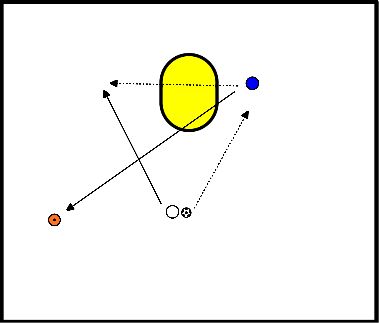
- Start and finish line, caps are scattered around the field.
- The number of caps is the number of players in the team x 2.
- Caps are brought to the end line one by one, the team that finishes first wins.
- 1Minute
- Shot > 2
- Passage with ball > 4
- Shot > 1
- 30 sec Bridge
- When player executes exercise, players take penalty throw`.
In this exercise it is hugely important;
- That the rebounder also continuously drops the ball quickly because 1 attacker starts at 6 or 7 meters with a dodge ball and immediately comes in for the through ball.
- Then a shot behind the post and then a shot to the side.
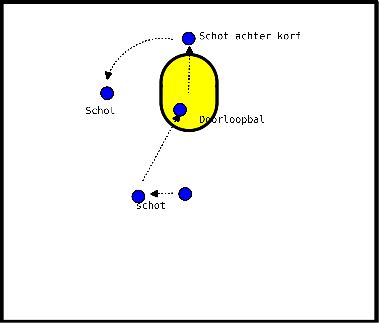
- Player A starts with the ball 2.5 meters diagonally in front of the post. Player B also stands 2.5 meters diagonally in front of the post.
- Player A throws the ball to player B and player B throws it back. Thus they bring the ball up to about 8 meters in front of the post.
- From there, player B starts for a through ball from the space indicated by player A.
- However, instead of player B taking the through ball, it now enters the declarer and player A comes in for a clearance ball. Player B catches the ball.
A variation on this:
Only throw the ball when player B runs next to/behind the basket and player B immediately makes a shot. Player A immediately runs in to catch the ball.
Only throw the ball when player B runs next to/behind the basket and player B immediately makes a shot. Player A immediately runs in to catch the ball.
There are more variations on this, such as:
- Most goals in a time frame of, say, 10 minutes
- Who scores 10 goals first
- Make it more difficult by deducting a point for each ball on the ground.
- Possibly with a 3rd player to rotate and keep a slightly slower pace.
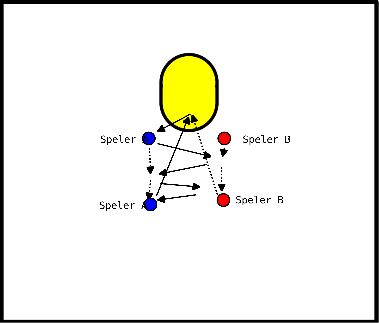
- Player A starts with the ball 2.5 meters diagonally in front of the post.
- Player B also stands 2.5 meters diagonally in front of the post.
- Player A throws the ball to player B and player B throws it back.
- Thus they bring the ball up to about 8 meters in front of the post.
- From there player B starts for a through ball from the space indicated by player A.
- Player A also runs in after it to catch the ball before it bounces on the ground.
Variations:
- Most goals in a 10-minute time frame.
- Whoever gets to 10 goals first.
- Make it harder by taking a point off every ball on the ground.
- Possibly with a 3rd person there to rotate through and keep a slightly slower pace.
- Most goals in a 10-minute time frame.
- Whoever gets to 10 goals first.
- Make it harder by taking a point off every ball on the ground.
- Possibly with a 3rd person there to rotate through and keep a slightly slower pace.
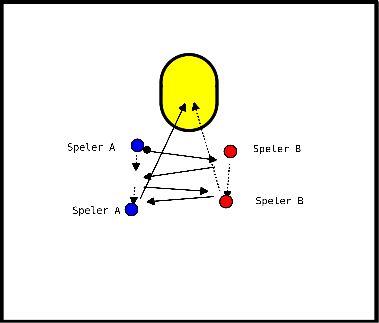
- Per person, everyone must score 10 through balls, this goes in groups of 3 or 4.
- In case of a miss, the whole group goes to the other side of the field on pace run and back.
- The one who missed takes the chance again.
- Until 10 are scored per player.
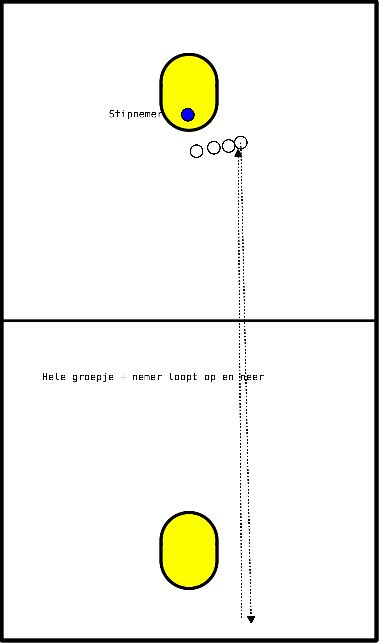
- All in a row, start at the back line.
- On the way out you sprint, on the way back you dribble.
- Every time you come to a line you do an exercise. 1x after the outward journey, 1x after the return journey.
- Exercises (numbers are free to fill in):
- Squats
- Push-ups (possibly on your knees)
- Jumping jacks
- Lunges, first with the left, then with the right.
- Burpees
Per task 1x quiet to practice and 3x fast.
- Left foot next to the ladder, right foot in the ladder.
- Right foot next to the ladder, left foot in the ladder.
- Sideways stepping through the ladder with both feet in all areas.
- Sideways hopping in and out of the ladder (so forward in and backward out and then diagonally to the next square) left leg.
- Sideways hopping in and out of the ladder (so forward in and backward out and then diagonally to the next square) right leg.







